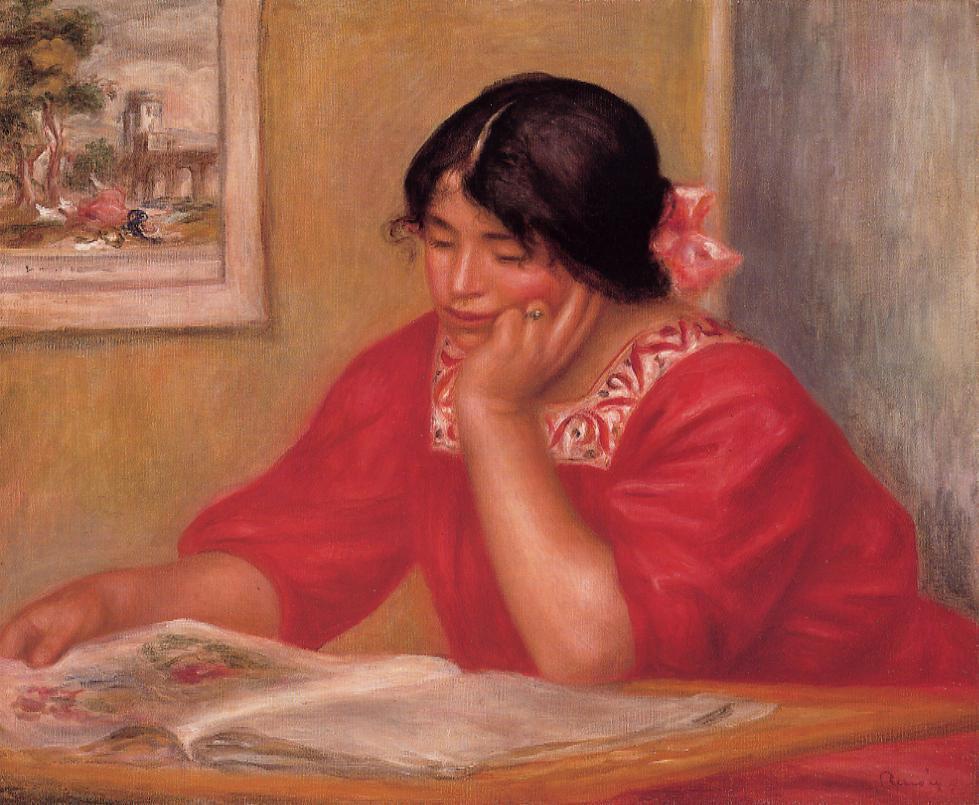art-Renoir.com
Auguste Renoir 1841-1919
Auguste Renoir - Leontine reading 1909
 Leontine reading |
From Sotheby's auction house:
A beautiful example of Renoir's late portraiture, the present work depicts Léontine, a young woman who came to work
for the Renoir family shortly after the birth of the artist's youngest son Claude in 1900. More often than not, these
housemaids and nurses became favourite models for the ageing artist, as was the case with Léontine. One of her
predecessors, the celebrated Gabrielle, posed for many figure studies and nudes that occupied Renoir to an
increasing extent after 1900. The present work adopts the format of a half-length figure seated at a table that
had been used in a series of memorable pictures of Gabrielle and the infant Jean in the mid-1890s. Showing Léontine
absorbed in her reading, seemingly unaware of being observed, Renoir has nevertheless painted a subtly provocative
portrait, exposing the woman's sensuality, the beauty of her facial features and of her body that so fully and
confidently dominates the composition.
The present work is closely related to Léontine et Coco (Claude Renoir)of 1909 , in which Renoir depicted the
young Léontine reading, perhaps seated at the same table, this time accompanied by the artist's son Coco. Her rich
dark hair is tied by the same pink ribbon, and she wears the same dress, painted in opulent red, the artist's favourite
colour at the time. In Léontine lisant, Renoir depicted the maid alone, seated against a wall on which there appears to
be hanging a Renoir landscape. This inclusion of a painting within a painting is a frequent feature in the artist's works
of this period.
Renoir probably captured the scene of the present work in his house in the south of France, which had been built to
satisfy his own physical needs and to accommodate his large family and frequent visitors. In 1906 he bought 'Les
Collettes', a large estate at Cagnes, where he spent the rest of his life. It was there that he painted a number of
outdoor scenes in which he recreated the idyllic lifestyle of the countryside, as well as portraits of various members of
his household. By this time Renoir had achieved significant acclaim and financial independence, and as he was no
longer obliged to paint commissioned portraits, he cherished the opportunities to paint the timeless quality of rural life
and intimate portraits of those who surrounded him. Among his most successful works of this time where those
depicting his children reading or playing, including some large-scale oils such as
Claude Renoir en clown.
Fascinated by the artist's exquisite rendering of female portraits, Théodore Duret remarked: 'Renoir excels at portraits.
Not only does he catch the external features, but through them he pinpoints the model's character and inner self. I
doubt whether any painter has ever interpreted woman in a more seductive manner. The deft and lively touches of
Renoir's brush are charming, supple and unrestrained, making flesh transparent and tinting the cheeks and lips with a
perfect living hue. Renoir's women are enchantresses'
(T. Duret, reprinted in Histoire des peintres impressionnistes,Paris, 1922, pp. 27-28).